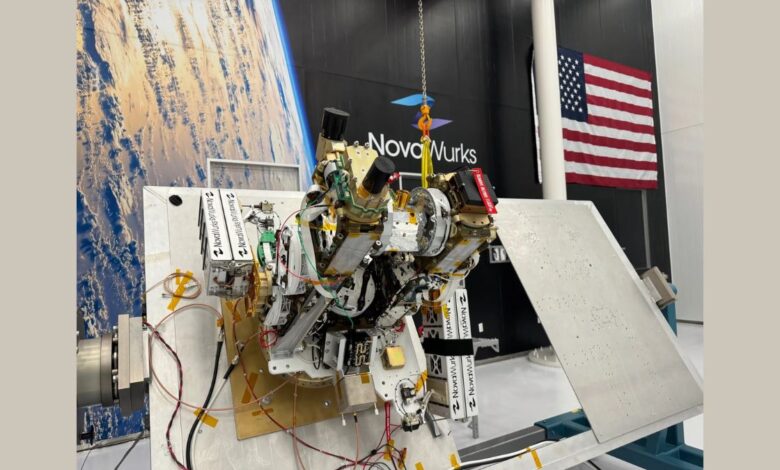NASA’s Modular Satellite Tech: Faster, Cheaper Missions

NASA’s Innovative Modular Satellite Technology
NASA is pioneering new scalable satellite technology designed to drastically reduce launch costs and accelerate mission timelines. The Athena EPIC (Economical Payload Integration Cost) mission exemplifies this approach, utilizing a compact, modular spacecraft platform that shares resources among onboard payloads. This innovative design eliminates the need for each instrument to have its own dedicated control system, leading to significant cost savings and faster deployment.
This modular architecture promises to deliver substantial benefits to taxpayers while enabling quicker access to space for crucial scientific instruments. The Athena EPIC mission, spearheaded by Langley Research Center, is slated to launch as a SpaceX rideshare mission in mid-2025. This mission will serve as a critical in-orbit demonstration of the modular satellite concept, paving the way for more efficient and cost-effective space exploration.
Key Advantages of Modular Satellites
- Reduced Costs: By sharing resources and eliminating redundant systems, modular satellites significantly lower overall mission costs.
- Faster Deployment: The standardized design and simplified integration process enable quicker deployment of scientific instruments and operational satellites.
- Increased Flexibility: Modular platforms can be easily adapted and reconfigured to accommodate a wide range of payloads and mission requirements.
- Enhanced Resilience: The modular design allows for easier replacement or repair of individual components, enhancing the overall resilience of the satellite system.
Scalable Satellite Platforms and Demonstration Missions
NASA is actively collaborating with industry partners to develop a variety of modular small satellite platforms. The Athena EPIC spacecraft, for instance, is constructed from eight interlocking Hyper-Integrated Satlet (HISat) modules. These modules collectively form a “SensorCraft” bus, which simplifies the integration of multiple instruments. This approach streamlines the entire satellite development process, from design and manufacturing to testing and launch.
In parallel with the Athena EPIC mission, NASA’s Pathfinder Technology Demonstrator (PTD) series is exploring the capabilities of standardized CubeSat buses. The PTD-3 mission, launched in 2022, showcased the potential of high-speed optical communications by carrying MIT Lincoln Laboratory’s TBIRD payload. This mission achieved a record-breaking 200 gigabits-per-second laser downlink from orbit, demonstrating the feasibility of transmitting large volumes of data from space to Earth.
Commercial Partnerships Driving Innovation
NASA is also leveraging the expertise of commercial partners to accelerate the development and deployment of modular satellite technology. Blue Canyon Technologies, for example, built the two CubeSats for NASA’s CubeSat Laser Infrared Crosslink (CLICK) mission and is providing four CubeSats for the upcoming Starling formation-flying demonstration. These collaborations highlight the growing role of the commercial space sector in advancing satellite technology and enabling new scientific discoveries.
Examples of Commercial Partnerships:
- Blue Canyon Technologies: Providing CubeSats for NASA’s CLICK and Starling missions.
- Terran Orbital: Supplying the standard 6U CubeSat bus for the PTD series.
The Future of Space Exploration with Modular Satellites
The development of scalable satellite buses promises to revolutionize space exploration by dramatically reducing mission costs and cycle times. Instead of relying on traditional, billion-dollar satellite platforms, the new “SensorCraft” design can slash costs to the single-digit millions per mission. This affordability makes it possible to launch a greater number of scientific missions and collect more data about our planet and the universe.
Smaller satellites are not only cheaper to build but also easier to replace in the event of failures. This increased resilience is particularly important for long-duration missions and those operating in harsh environments. Furthermore, by reusing existing parts and leveraging standardized designs, teams can significantly accelerate the development process. For example, the optical sensor on the Athena EPIC mission was assembled from spare components of NASA’s CERES climate-observation satellites.
Scientific Gains and Broader Applications
NASA officials emphasize that the shift towards smaller, more efficient satellites necessitates a less traditional and more streamlined path to launch. This new approach will maximize the scientific return from each mission and enable a wider range of applications, including:
- Climate Monitoring: Deploying constellations of sensors to track changes in Earth’s atmosphere and oceans.
- Weather Forecasting: Improving the accuracy and timeliness of weather predictions.
- Disaster Response: Providing real-time imagery and data to aid in disaster relief efforts.
- Space Exploration: Enabling new missions to study the Moon, Mars, and other celestial bodies.
| Feature | Benefit |
|---|---|
| Modular Design | Reduced costs, faster deployment, increased flexibility |
| Standardized Buses | Streamlined integration, accelerated development |
| Commercial Partnerships | Access to expertise, innovative technologies, cost-effective solutions |
By embracing modular satellite technology, NASA is paving the way for a future of more affordable, accessible, and impactful space exploration.




